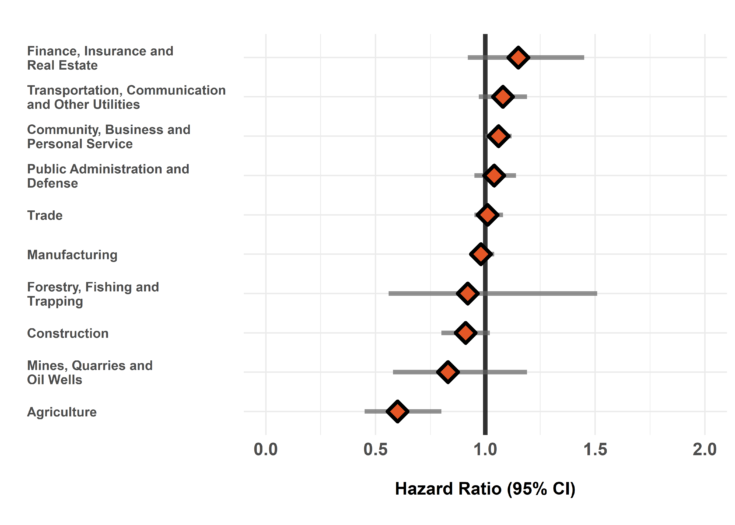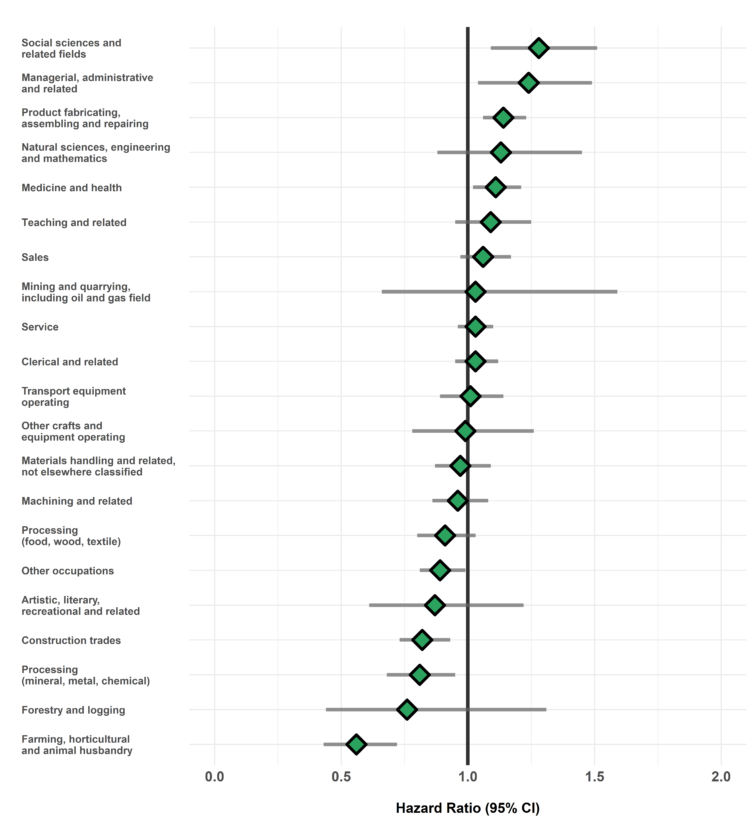Thyroid Cancer
Background
The Canadian Cancer Society estimates that thyroid cancer will be the seventh most commonly diagnosed cancer overall in Canada in 2020, and the fifth most commonly diagnosed in females [1]. It is most commonly diagnosed among people aged 20 to 55.
Little is known about occupational risk factors for thyroid cancer. Exposure to ionizing radiation (from radiation therapy, diagnostic imaging or nuclear fallout) during childhood and adolescence is the strongest known risk factor for thyroid cancer. In the workplace, the most consistent associations have been seen for radiation-exposed workers and health care occupations, while some other studies have seen an increased risk in pesticide-exposed workers and agricultural occupations [2].
Known occupational risk factors
-
- Ionizing radiation (exposure during adulthood) [3]
- X- and gamma-radiation from performing diagnostic imaging
- Administering radioactive iodine treatment
- Ionizing radiation (exposure during adulthood) [3]
Possible occupational risk factors
-
- Pesticides (such as organochlorines) [2,4]
Key Findings
Some previous studies have found increased risk of thyroid cancer among workers in agricultural workers, who may be exposed to pesticides. However, no increased risks were seen among these groups in the ODSS.
Healthcare
 Medical workers may be exposed to low-dose ionizing radiation when they administer radiation therapy or perform diagnostic imaging. Exposure to ionizing radiation during adulthood is a possible risk factor for thyroid cancer.
Medical workers may be exposed to low-dose ionizing radiation when they administer radiation therapy or perform diagnostic imaging. Exposure to ionizing radiation during adulthood is a possible risk factor for thyroid cancer.
-
- Occupations in medicine and health: 1.11 times the risk
- Denturists, dental hygienists, dental assistants and dental technicians: 2.35 times the risk
- Radiological technicians: 1.33 times the risk
- Nurses, graduate, except supervisors: 1.21 times the risk
- Diagnostic and therapeutic services industry, not elsewhere specified*: 1.71 times the risk
- Hospitals: 1.11 times the risk
- Occupations in medicine and health: 1.11 times the risk
*This industry includes laboratories (dental, medical, x-ray, etc.) providing analysis, diagnosis or treatment service to the medical or dental professions or to patients on prescription of a physician or dentist, and organizations such as the Victorian Order of Nurses, Red Cross Blood Transfusion Service, and St. John Ambulance.
Relative Risk by Industry and Occupation
Figure 1. Risk of thyroid cancer diagnosis among workers employed in each industry group relative to all others, Occupational Disease Surveillance System (ODSS), 1983-2016

The hazard ratio is an estimate of the average time to diagnosis among workers in each industry/occupation group divided by that in all others during the study period. Hazard ratios above 1.00 indicate a greater risk of disease in a given group compared to all others. Estimates are adjusted for birth year and sex. The width of the 95% Confidence Interval (CI) is based on the number of cases in each group (more cases narrows the interval).
Figure 2. Risk of thyroid cancer diagnosis among workers employed in each occupation group relative to all others, Occupational Disease Surveillance System (ODSS), 1983-2016

The hazard ratio is an estimate of the average time to diagnosis among workers in each industry/occupation group divided by that in all others during the study period. Hazard ratios above 1.00 indicate a greater risk of disease in a given group compared to all others. Estimates are adjusted for birth year and sex. The width of the 95% Confidence Interval (CI) is based on the number of cases in each group (more cases narrows the interval).
Table of Results
Table 1. Surveillance of thyroid cancer: Number of cases, workers employed, and hazard ratios in each industry (SIC)
| SIC Code * | Industry Group | Number of cases | Number of workers employed | Hazard Ratio (95% CI) † |
| 1 | Agriculture | 46 | 35,007 | 0.60 (0.45-0.80) |
| 2/3 | Forestry, Fishing and Trapping |
16 | 10,699 | 0.92 (0.56-1.51) |
| 4 | Mines, Quarries and Oil Wells |
30 | 23,203 | 0.83 (0.58-1.19) |
| 5 | Manufacturing | 1,606 | 693,458 | 0.98 (0.93-1.04) |
| 6 | Construction | 301 | 210,956 | 0.91 (0.80-1.02) |
| 7 | Transportation, Communication and Other Utilities |
421 | 197,154 | 1.08 (0.97-1.19) |
| 8 | Trade | 1,061 | 429,108 | 1.01 (0.95-1.08) |
| 9 | Finance, Insurance and Real Estate |
75 | 23,974 | 1.15 (0.92-1.45) |
| 10 | Community, Business and Personal Service |
2,049 | 599,126 | 1.06 (1.00-1.12) |
| 11 | Public Administration and Defense |
524 | 190,795 | 1.04 (0.95-1.14) |
| * SIC: Standard Industrial Classification (1970) | ||||
| † Hazard rate in each group relative to all others | ||||
Table 2. Surveillance of thyroid cancer: Number of cases, workers employed, and hazard ratios in each occupation (CCDO) group
| CCDO Code * | Occupation Group | Number of cases | Number of workers employed | Hazard Ratio (95% CI) † |
| 11 | Managerial, administrative and related |
121 | 30,958 | 1.24 (1.04-1.49) |
| 21 | Natural sciences, engineering and mathematics |
63 | 26,327 | 1.13 (0.88-1.45) |
| 23 | Social sciences and related fields |
146 | 30,676 | 1.28 (1.09-1.51) |
| 25 | Religion | 0 | 128 | — |
| 27 | Teaching and related | 215 | 48,396 | 1.09 (0.95-1.25) |
| 31 | Medicine and health | 641 | 135,167 | 1.11 (1.02-1.21) |
| 33 | Artistic, literary, recreational and related |
33 | 14,985 | 0.87 (0.61-1.22) |
| 41 | Clerical and related | 649 | 197,206 | 1.03 (0.95-1.12) |
| 51 | Sales | 467 | 148,030 | 1.06 (0.97-1.17) |
| 61 | Service | 1,149 | 370,720 | 1.03 (0.96-1.10) |
| 71 | Farming, horticultural and animal husbandry |
57 | 50,138 | 0.56 (0.43-0.72) |
| 73 | Fishing, hunting, trapping and related |
0 | 558 | — |
| 75 | Forestry and logging | 13 | 10,684 | 0.76 (0.44-1.31) |
| 77 | Mining and quarrying, including oil and gas field |
20 | 13,040 | 1.03 (0.66-1.59) |
| 81 | Processing (mineral, metal, chemical) |
142 | 79,214 | 0.81 (0.68-0.95) |
| 82 | Processing (food, wood, textile) |
232 | 99,223 | 0.91 (0.80-1.03) |
| 83 | Machining and related | 351 | 189,405 | 0.96 (0.86-1.08) |
| 85 | Product fabricating, assembling and repairing |
821 | 328,254 | 1.14 (1.06-1.23) |
| 87 | Construction trades | 275 | 215,577 | 0.82 (0.73-0.93) |
| 91 | Transport equipment operating |
296 | 168,082 | 1.01 (0.89-1.14) |
| 93 | Materials handling and related, not elsewhere classified |
322 | 153,026 | 0.97 (0.87-1.09) |
| 95 | Other crafts and equipment operating |
67 | 28,303 | 0.99 (0.78-1.26) |
| 99 | Other occupations not elsewhere classified | 404 | 215,202 | 0.89 (0.81-0.99) |
| * CCDO: Canadian Classification Dictionary of Occupations (1971) | ||||
| † Hazard rate in each group relative to all others | ||||
Please note that ODSS results shown here may differ from those previously published or presented. This may occur due to changes in case definitions, methodological approaches, and the ongoing nature of the surveillance cohort.
References
- Brenner DR, Weir HK, Demers AA, Ellison LF, Louzado C, Shaw A, Turner D, Woods RR, Smith LM. Projected estimates of cancer in Canada in 2020. Can Med Assoc J. 2020;192(9):E199–205.
- Aschebrook-Kilfoy B, Ward MH, Della Valle CT, Friesen MC. Occupation and thyroid cancer. Occup Environ Med. 2014;71(5):366–80.
- International Agency for Research on Cancer (IARC). List of Classifications by cancer sites with sufficient or limited evidence in humans, IARC Monographs Volumes 1-127 (2020).
- Han MA, Kim JH, Song HS. Persistent organic pollutants, pesticides, and the risk of thyroid cancer: Systematic review and meta-analysis. Eur J Cancer Prev. 2019;28(4):344–9.
